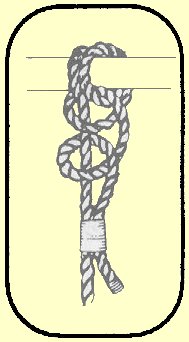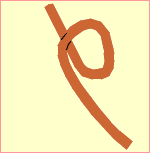
(Bowline)
Below are
common knots and there uses in tying up your Seabee.
Some of the knots below will never be used yet some will be used daily!
It is recommended that at least three 15 foot lengths of line (rope) be
aboard the Seabee at all times. (This does not include the anchor line
which is a whole different animal). These lines are not only for tying down
the wings and tail, but may be used as a casting lines in "tight" situations.
Line diameter of one-half inch is MINIMUM for the Seabee!
NEVER use Polypropylene or Nylon line! It just isn't strong enough over time
and is very stiff when tying knots.
The sun (ultra-violet rays) takes the strength out of these type lines.
The above illustrations and knot explanations are courtesy of Lehigh Group®, Macungie, PA 18062.
Seabee Home
Updated October 5, 2003
Some of the knots below will never be used yet some will be used daily!
It is recommended that at least three 15 foot lengths of line (rope) be
aboard the Seabee at all times. (This does not include the anchor line
which is a whole different animal). These lines are not only for tying down
the wings and tail, but may be used as a casting lines in "tight" situations.
Line diameter of one-half inch is MINIMUM for the Seabee!
NEVER use Polypropylene or Nylon line! It just isn't strong enough over time
and is very stiff when tying knots.
The sun (ultra-violet rays) takes the strength out of these type lines.
 |
Preventing
Twisted Rope from Unraveling:
Nylon, Polyester, Polypropylene: Tape rope around the circumference as illustrated. Cut in the middle leaving tape intact on each side. When cutting these fibers with a pocket knife or scissors, the cut ends should be fused by a matchflame to prevent untwisting. Tape is unnecessary if a "hot knife" is used as heat will melt and fuse the cut ends. Manila, Sisal: Tape the rope as illustrated below. Cut in the middle as that each end remains permanently taped. Natural fibers do not fuse with heat. |
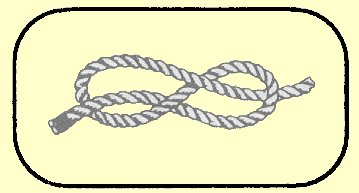 |
Figure 8 Knot: The figure
eight knot is used at the end of a rope to temporarily prevent the
strands from unlaying (unraveling). |
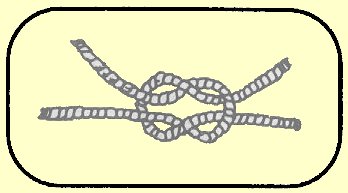 |
Square Knot: (Reef
Knot) If tied with two ends of unequal size, or if one end is
stiffer or more slippery than the other, it is bound to slip. Under no
circumstances should it be used as a bend. (A bend is tying two ropes
together). There have probably been more lives lost as a result
of using a SQUARE KNOT as a bend. |
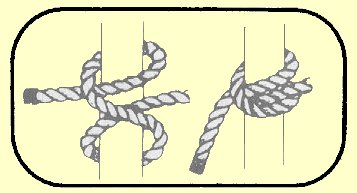 |
Clove Hitch: Also known as
Builder's Hitch because of its wide use by builders in fastening
staging to upright posts. |
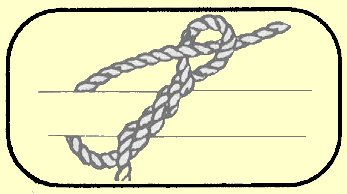 |
Timber Hitch: This knot is
very useful for hoisting and as towlines and holds without
slipping or jamming. |
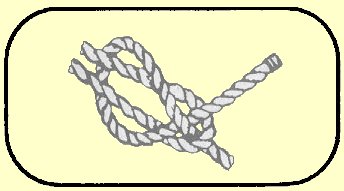
|
Sheet Bend: Also known as
Weaver's Knot and used aboard ships for joining small or medium sized
ropes. Popular also in textile mills for joining threads or yarns. The
only knot that, no matter how tight, can easily be unfastened.
Can be used with two different guages of rope. |
|
|
Fisherman's Bend: An
important knot because of its strength and simplicity and is more
secure when end is seized as shown. A good wing and tail tiedown knot. |
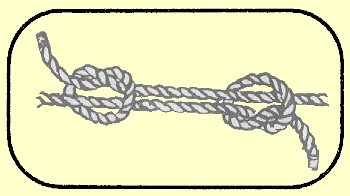 |
Fisherman's Knot: The
fisherman's knot is probably the strongest known method of joining fine
lines, such as fishing line. Don't try to get it untied once it is put
under stress. |
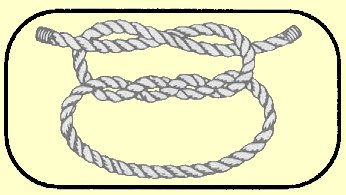 |
Surgeon's Knot: This knot
is usually
tied with twine. The surgeon's knot is a modified form of the reef knot
(square
knot) and the extra turn taken in the first tie prevents slipping
before
the knot is completed. |
 |
A: Tying
two ends together. B: Knot in end of line to prevent fraying. (Figure eight) C: Securing line to post. (Modified Sheet Bend) |
The above illustrations and knot explanations are courtesy of Lehigh Group®, Macungie, PA 18062.
Seabee Home
Updated October 5, 2003
